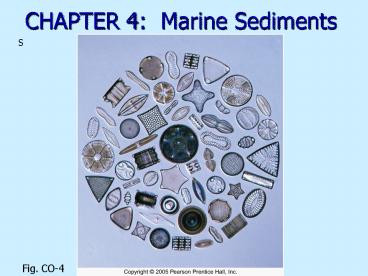CHAPTER 4: Marine Sediments - PowerPoint PPT Presentation
1 / 49
Title:
CHAPTER 4: Marine Sediments
Description:
CHAPTER 4: Marine Sediments S Fig. CO-4 Marine sediments Eroded rock particles and fragments Transported to or produced in the ocean Deposit by settling through water ... – PowerPoint PPT presentation
Number of Views:1452
Avg rating:3.0/5.0
Title: CHAPTER 4: Marine Sediments
1
CHAPTER 4 Marine Sediments
S
Fig. CO-4
2
Marine sediments
S
- Eroded rock particles and fragments
- Transported to or produced in the ocean
- Deposit by settling through water column
- Oceanographers decipher Earth history through
studying sediments
3
Classification of marine sediments
P
- Classified by origin
- Lithogenous (derived from land)
- Biogenous (derived from organisms)
- Hydrogenous (derived from water)
- Cosmogenous (derived from outer space)
4
Lithogenous sediments
P
- Eroded rock fragments from land (origin)
- Transported from land by
- Water (e.g., river transported sediment)
- Wind (e.g., windblown dust)
- Ice (e.g., ice-rafted rocks)
- Gravity (e.g., turbidity currents)
5
P
BY PERCENT
Transport Mechanism
6
S
7
Lithogenous sediments
S
Fig. 4.5
8
Lithogenous sediments
P
- Most lithogenous sediments at continental margins
- Coarser sediments closer to shore
- Finer sediments farther from shore WHY?
- Mainly mineral quartz (SiO2)
9
P
10
S
distance rate x time d rt t d/r 4km/
2.5cm/sec 4,000m/ 2.5cm/sec 4,000m(100cm.m)/
2.5cm/sec 400,000cm / 2.5cm/sec 160,000sec/
24hr/day x 3600sec/hr 160,000sec/
86,400sec/day 1.85 days
11
S
Clay sinks 10,000 times slower than sank, so 1.8
days x 10,000 (or 104) 18,000 days 18,000 days
49.3 years 365 days/year
12
S
Smaller particles have a larger SA/Vol.
ratio, increasing the frictional drag (sinking
rates) and making small particles sink more
slowly than large particles
13
Relationship of fine-grained quartz and
prevailing winds
S
Fig. 4.6b
14
Brazos River Meets the Gulf of Mexico
S
- FLOCCULATION - THE JOINING TOGETHER OF
ELECTRICALLY CHARGED CLAY PARTICLES WHICH SETTLE
MORE RAPIDLY THAN INDIVIDUAL ONES
15
S
Brazos River
16
04_06t
S
17
Distribution of sediments
S
- Neritic
- Shallow water deposits
- Close to land
- Dominantly lithogenous
- Typically deposited quickly
- Pelagic
- Deeper water deposits
- Finer-grained sediments
- Deposited slowly
- UNDERSTANDING THE PROCESSES WOULD ALLOW YOU TO
GENERATE THIS TABLE YOURSELVES
18
Neritic lithogenous sediments
S
- Beach deposits
- Mainly wave-deposited quartz-rich sands
- Continental shelf deposits
- Relict sediments
- Turbidite deposits
- Glacial deposits
- High latitude continental shelf
19
(No Transcript)
20
Pelagic lithogenous sediments
S
- Sources of fine material
- Volcanic ash (volcanic eruptions)
- Wind-blown dust
- Fine grained material transported by deep ocean
currents - Abyssal clay (red clay)
- Oxidized iron
- Abundant if other sediments absent
21
Biogenous marine sediments
P
- Hard remains of once-living organisms
- Shells, bones, teeth
- Macroscopic (large remains)
- Microscopic (small remains)
- Tiny shells or tests settle through water column
- Biogenic ooze (30 or more tests)
- Mainly algae and protozoans
22
Biogenous marine sediments
P
- Commonly either calcium carbonate (CaCO3) or
silica (SiO2 or SiO2.nH2O) - Usually planktonic (free-floating)
23
Silica in biogenic sediments
P
- Diatoms (algae)
- Photosynthetic
- Diatomaceous earth
24
Siliceous ooze
S
- Seawater undersaturated with silica
- Siliceous ooze commonly associated with high
biologic productivity in surface ocean
Fig. 4.12
25
Calcium carbonate in biogenous sediments
P
- Coccolithophores (algae)
- Photo-synthetic
- Coccoliths (nanno-plankton)
26
S
White Cliffs of Dover
27
Calcium carbonate in biogenous sediments
P
- Foraminifera (protozoans)
- Use external food
- Calcareous ooze
28
Living Foraminifera
S
29
Distribution of biogenous sediments
S
- Most common as pelagic deposits
- Factors controlling distribution
- Productivity
- Destruction (dissolution)
30
Calcareous ooze and the CCD
P
- Warm, shallow ocean saturated with calcium
carbonate - Cool, deep ocean undersaturated with calcium
carbonate - Lysocline--depth at which CaCO3 begins to
dissolve rapidly - Calcite compensation depth CCD--depth where CaCO3
readily dissolves
31
Calcareous ooze and the CCD
S
Fig. 4.13
- Scarce calcareous ooze below 5000 m in modern
ocean - Ancient calcareous oozes at greater depths if
moved by sea floor spreading
32
Distribution of calcareous oozes in surface
sediments of modern seafloor
S
Why in these places?
33
Hydrogenous marine sediments
P
- Minerals precipitate directly from seawater
- Manganese nodules
- Phosphates
- Carbonates
- Metal sulfides
- Small proportion of marine sediments
- Distributed in diverse environments
34
P
35
Iron-Manganese nodules
S
- Fist-sized lumps of manganese, iron, and other
metals - Very slow accumulation rates
Fig. 4.15a
36
S
37
Manganese nodules
S
Fig. 4.26
38
Cosmogenous marine sediments
P
- Macroscopic meteor debris
- Microscopic iron-nickel and silicate spherules
- Tektites
- Space dust
- Overall, insignificant proportion of marine
sediments
39
04_C
S
40
S
Microtektites - extraterrestrial
41
04_D
S
42
04_E
S
43
04_F
S
44
Mixtures of marine sediments
P
- Usually mixture of different sediment types
- For example, biogenic oozes can contain up to 70
non-biogenic components - Typically one sediment type dominates in
different areas of the sea floor
45
Distribution of neritic and pelagic marine
sediments
P
Fig. 4.19
46
04_T04
P
1 m
.01 m
.001 m
47
S
48
S
49
04_18
P































